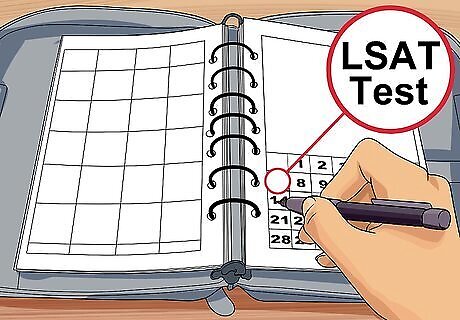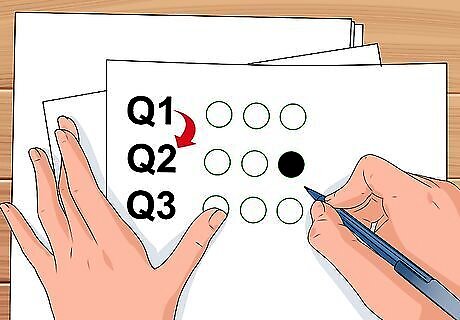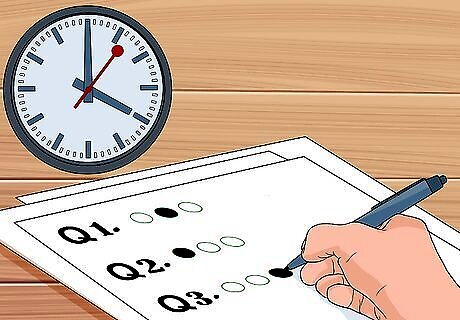
views
Preparing for the LSAT

Familiarize yourself with the LSAT format. The format and types of questions on the LSAT aren’t a secret, and you can familiarize yourself with what to expect. The LSAT is comprised of five sets of multiple-choice questions, separated into 35-minute sections. At the end of these sections, a final 35-minute section goes toward a writing sample, which isn’t scored but is sent along with your LSAT score to each law school to which you apply. One of the five multiple-choice sections isn’t scored either, but this section mostly includes newer questions, which the governing LSAT board tries out for future iterations of the test.

Familiarize yourself with what the test measures. The LSAT doesn’t actually measure knowledge of law proceedings but merely the types of skills necessary to succeed in law school. The three major types of multiple-choice questions on the LSAT include: Reading comprehension questions - These measure your ability to comprehend complex texts with accuracy while drawing conclusions from the content. Analytical reasoning questions - These questions test your ability to comprehend the relationships between certain objects and to draw rational conclusions from the structure of those relationships. Logical reasoning questions - These questions measure your ability to analyze and evaluate ordinary-language arguments, as well as your ability to complete them.

Take practice tests. The Law School Admission Council (LSAC) is the body that administers the LSAT, and they offer a free online sample test, which you can find here. This sample test is the actual LSAT from June of 2007, so you can see the exact types of questions you can expect. Don’t panic if you do poorly and run out of time on your first sample test. This is normal. Other sample tests are available online and through official LSAT testing centers. You should also look into these tests, so you can take several with fresh questions that you don’t already know.

Try out different test strategies. The LSAT is a test of time management on the questions just as much as it is in logic and comprehension. Finding the strategy for questions that both maximizes correct answers and time efficiency is essential. Try different ways of approaching the different sections to find out what works best for you. For example, when it comes to the long texts in the reading comprehension sections, some students prefer to closely read the text before reading the questions, whereas other students prefer to read the questions associated with the text before reading it.

Take logic puzzle tests. You can find numerous logic puzzle tests online and in official LSAT tutoring locations to help develop skills related to the analytical and logical reasoning sections of the LSAT. Practice these often in addition to the examples you see on the practice tests.

Consider other prep courses and materials. If you’re not happy with your scores on the practice tests, then consider taking a prep course or investing in official LSAT study guides. Though these materials usually aren’t cheap, you may see substantial differences in your scores when you have some help as opposed to going it on your own.

Do not forget the writing sample. Though the writing sample isn’t scored as part of the actual test, it’s still submitted to law schools along with your application, and therefore, weighed in the admission process. The writing sample for the LSAT takes the form of a decision problem wherein you must choose between two courses of action or positions on an argument. The question will be formulated in a manner that makes each position defensible, so there’s no right or wrong answer, only how well you can back up the position you choose. Practice writing these types of samples with a focus on clear, concise, and precise arguments that you have organized logically. You can find two official practice topics from LSAC here.

Use actual time constraints. It’s just as important to practice under the real-world conditions of the LSAT as it is to practice with accurate question types. Acing reading comprehension doesn’t do any good if you spend all 35 minutes on two questions. As you get more comfortable with the format and different question types, ensure that you hold yourself to the same time constraints as you’ll experience during the actual test.

Practice for at least fifty hours. As you prepare for the LSAT, expect to give yourself a full fifty hours of study time and practice tests to prepare for the real thing.
Taking the Test

Schedule the test appropriately. You can find the schedule of available LSAT test dates here. If you have an LSAC account, you’ll receive your score by email around three weeks after your test date, so remember to coordinate when you take the test with the due dates for applications at your respective law schools.

Show up prepared. As with any other test you’ve taken over the years, you’ll perform better with a full night of sleep the night before and a good breakfast the morning of the test. You can’t concentrate of long text passages and logic questions if you’re tired and/or hungry.

Start with the easier questions. Every question on the LSAT is equally weighted, and you receive points for correct answers, but you do not receive deductions for incorrect answers. On a test where a 65% puts you in the 75th percentile, this means that maximizing the number of questions you answer correctly is more important than agonizing over individual questions where you get stuck. This also means that you shouldn’t be afraid to skip questions where you get stuck and come back to them after less time-consuming ones.

Give the proper amount of time to each question. While you might not end up doing each question in order, ensure that you focus completely on each question when you get to it. Some of the questions have “trap” answer choices, which are specifically meant to be more difficult for students rushing through the test. Additionally, do not try to get creative with regard to how some of the answers could apply. Use the process of elimination for each answer, focusing on why answers are wrong rather than how they could be right.

Do not leave any empty bubbles. As previously stated, you are not penalized for answering a question incorrectly. This means that in the final minute of each section, you should fill in any empty bubbles from questions you skipped or haven’t gotten to. Even if you fill in ten bubbles at random, you have the odds of getting two right and potentially increasing your score by two points.



















Comments
0 comment